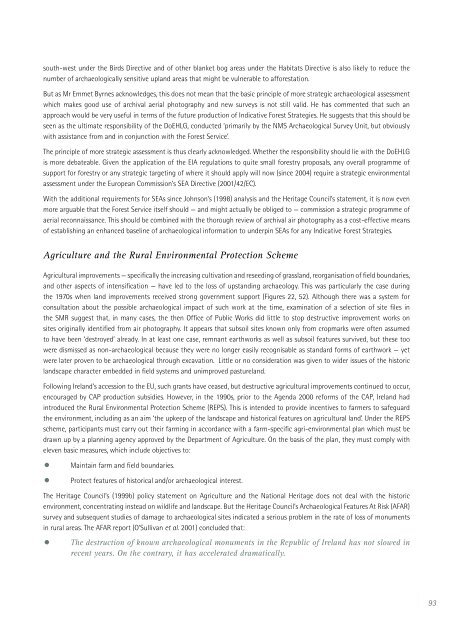Aerial Archaeology in Ireland - The Heritage Council
Aerial Archaeology in Ireland - The Heritage Council
Aerial Archaeology in Ireland - The Heritage Council
You also want an ePaper? Increase the reach of your titles
YUMPU automatically turns print PDFs into web optimized ePapers that Google loves.
south-west under the Birds Directive and of other blanket bog areas under the Habitats Directive is also likely to reduce the<br />
number of archaeologically sensitive upland areas that might be vulnerable to afforestation.<br />
But as Mr Emmet Byrnes acknowledges, this does not mean that the basic pr<strong>in</strong>ciple of more strategic archaeological assessment<br />
which makes good use of archival aerial photography and new surveys is not still valid. He has commented that such an<br />
approach would be very useful <strong>in</strong> terms of the future production of Indicative Forest Strategies. He suggests that this should be<br />
seen as the ultimate responsibility of the DoEHLG, conducted ‘primarily by the NMS Archaeological Survey Unit, but obviously<br />
with assistance from and <strong>in</strong> conjunction with the Forest Service’.<br />
<strong>The</strong> pr<strong>in</strong>ciple of more strategic assessment is thus clearly acknowledged. Whether the responsibility should lie with the DoEHLG<br />
is more debateable. Given the application of the EIA regulations to quite small forestry proposals, any overall programme of<br />
support for forestry or any strategic target<strong>in</strong>g of where it should apply will now (s<strong>in</strong>ce 2004) require a strategic environmental<br />
assessment under the European Commission’s SEA Directive (2001/42/EC).<br />
With the additional requirements for SEAs s<strong>in</strong>ce Johnson’s (1998) analysis and the <strong>Heritage</strong> <strong>Council</strong>’s statement, it is now even<br />
more arguable that the Forest Service itself should — and might actually be obliged to — commission a strategic programme of<br />
aerial reconnaissance. This should be comb<strong>in</strong>ed with the thorough review of archival air photography as a cost-effective means<br />
of establish<strong>in</strong>g an enhanced basel<strong>in</strong>e of archaeological <strong>in</strong>formation to underp<strong>in</strong> SEAs for any Indicative Forest Strategies.<br />
Agriculture and the Rural Environmental Protection Scheme<br />
Agricultural improvements — specifically the <strong>in</strong>creas<strong>in</strong>g cultivation and reseed<strong>in</strong>g of grassland, reorganisation of field boundaries,<br />
and other aspects of <strong>in</strong>tensification — have led to the loss of upstand<strong>in</strong>g archaeology. This was particularly the case dur<strong>in</strong>g<br />
the 1970s when land improvements received strong government support (Figures 22, 52). Although there was a system for<br />
consultation about the possible archaeological impact of such work at the time, exam<strong>in</strong>ation of a selection of site files <strong>in</strong><br />
the SMR suggest that, <strong>in</strong> many cases, the then Office of Public Works did little to stop destructive improvement works on<br />
sites orig<strong>in</strong>ally identified from air photography. It appears that subsoil sites known only from cropmarks were often assumed<br />
to have been ‘destroyed’ already. In at least one case, remnant earthworks as well as subsoil features survived, but these too<br />
were dismissed as non-archaeological because they were no longer easily recognisable as standard forms of earthwork — yet<br />
were later proven to be archaeological through excavation. Little or no consideration was given to wider issues of the historic<br />
landscape character embedded <strong>in</strong> field systems and unimproved pastureland.<br />
Follow<strong>in</strong>g <strong>Ireland</strong>’s accession to the EU, such grants have ceased, but destructive agricultural improvements cont<strong>in</strong>ued to occur,<br />
encouraged by CAP production subsidies. However, <strong>in</strong> the 1990s, prior to the Agenda 2000 reforms of the CAP, <strong>Ireland</strong> had<br />
<strong>in</strong>troduced the Rural Environmental Protection Scheme (REPS). This is <strong>in</strong>tended to provide <strong>in</strong>centives to farmers to safeguard<br />
the environment, <strong>in</strong>clud<strong>in</strong>g as an aim ‘the upkeep of the landscape and historical features on agricultural land’. Under the REPS<br />
scheme, participants must carry out their farm<strong>in</strong>g <strong>in</strong> accordance with a farm-specific agri-environmental plan which must be<br />
drawn up by a plann<strong>in</strong>g agency approved by the Department of Agriculture. On the basis of the plan, they must comply with<br />
eleven basic measures, which <strong>in</strong>clude objectives to:<br />
•<br />
•<br />
Ma<strong>in</strong>ta<strong>in</strong> farm and field boundaries.<br />
Protect features of historical and/or archaeological <strong>in</strong>terest.<br />
<strong>The</strong> <strong>Heritage</strong> <strong>Council</strong>’s (1999b) policy statement on Agriculture and the National <strong>Heritage</strong> does not deal with the historic<br />
environment, concentrat<strong>in</strong>g <strong>in</strong>stead on wildlife and landscape. But the <strong>Heritage</strong> <strong>Council</strong>’s Archaeological Features At Risk (AFAR)<br />
survey and subsequent studies of damage to archaeological sites <strong>in</strong>dicated a serious problem <strong>in</strong> the rate of loss of monuments<br />
<strong>in</strong> rural areas. <strong>The</strong> AFAR report (O’Sullivan et al. 2001) concluded that:<br />
• <strong>The</strong> destruction of known archaeological monuments <strong>in</strong> the Republic of <strong>Ireland</strong> has not slowed <strong>in</strong><br />
recent years. On the contrary, it has accelerated dramatically.<br />
93

















